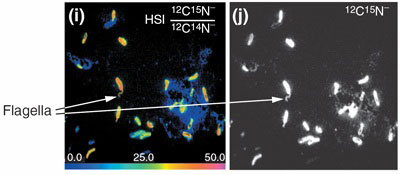| Posted: May 24, 2010 |
NSF funds $3.7m NanoSIMS imaging system |
|
(Nanowerk News) The National Science Foundation’s Major Research and Instrumentation (MRI) Program recently funded a $3.7 million NanoSIMS imaging mass spectrometer for 13 Arizona State University (ASU) scientists and a large number of collaborators working on diverse topics involving both soft (biological) and hard materials (e.g. minerals).
|
|
This nano-scale imaging Secondary Ion Mass Spectrometer will produce chemical and isotopic images of samples ranging from bacteria to meteorites, with the ability to visualize features smaller than 50 nanometers (less than one-thousandth the width of a human hair). It will be used to trace details of metabolism in bacteria performing such roles as nitrogen fixation, pollutant cleanup or generation of biofuels, and to probe issues relating to the origin of life. Studies of microscopic atmospheric aerosol particles will advance our understanding of Earth’s climate and global warming.
|
 |
| Nitrogen-fixing bacteria seen using a NANOSIMS.
|
|
Measurements in tiny grains in meteorites will cast light on the early history of the solar system, while determination of the precise chemistry of tiny crystals that form in the last few hours before volcanic eruptions will allow ASU scientists to correlate time-resolved magma chemistry with external seismographic data to improve predictability of these catastrophic events.
|
|
“The NanoSIMS brings to ASU the capability for chemical and isotopic analysis, and imaging, at nanometer scales. It is one of only seven such instruments in the U.S.,” stated Peter Williams, professor in the department of chemistry and biochemistry and principal investigator on the award. “The instrument will support an exceptionally diverse range of research areas. Initially these will include astrochemistry, astrobiology, vulcanology, climate science, environmental microbiology, bioenergy research, biosensors and nanoparticle-cell interactions, but the instrument will be a resource that will be accessible to the entire ASU research community.”
|
|
In fact many undergraduate and graduate students will use the equipment in their research projects and will be trained in imaging science at the state of the art.
|
|
Williams has worked in the SIMS field since 1974. At ASU in 1984 he acquired an early ion microscope and began a research program split between theoretical studies of ion emission and sputtering, developments in analytical methodology and instrumental design, and applications of SIMS to wide-ranging analytical problems in areas such as semiconductor materials and, in particular geochemistry. Since 1985, Professor Richard Hervig of the School of Earth and Space Exploration (one of 12 co-PIs) and Williams have collaborated in building an open analytical facility, with local, national and international collaborations.
|
|
Professor James Anderson (co-PI), a research scientist in the Ira A. Fulton Schools of Engineering, will measure isotope ratios in submicron aerosol particles to determine the origins and chemistry of these particles that nucleate water droplets in clouds and so affect global climate.
|
|
Willem Vermaas (co-PI), professor in the School of Life Sciences, will utilize the NanoSIMS to study lipid biogenesis in bacteria to improve their value in biofuel production.
|
|
The ASU NanoSIMS instrument will enable co-PIs Professors Ariel Anbar and Everett Shock, both in the department of chemistry and biochemistry and the School of Earth and Space Exploration, and Regents’ Professor James Elser (School of Life Sciences) to probe the metabolic pathways and mechanisms of element uptake and transfer in the ecosystems where biogeochemical cycles first evolved. A major component of this work is the drive to understand life’s origin on the Earth, by studying the biology and ecology of terrestrial microbes, particularly extremophiles. Scientists have discovered an astonishing diversity of microbial metabolisms in the past 30 years, transforming our concept of “habitability.” Hydrothermal ecosystems are the longest continuously occupied habitats on Earth. The microbes living there conduct every step of the complex element cycles that form the foundation of biogeochemistry. There is reason to believe that some of these organisms – extremophiles – may closely resemble some of the earliest-evolving life forms on Earth. Connections are being made to the relatively new discipline of astrobiology that explores the possibility of life beyond the Earth.
|
|
Research Professor Lynda Williams (co-PI), in the School of Earth and Space Exploration in the College of Liberal Arts and Sciences will use the new instrument to study nanoparticle-cell interactions involved in the healing action of medicinal clays.
|
|
Other co-PIs in the project include Meenakshi Wadhwa, Director of the Center for Meteorite Studies, Professors Paul Westerhoff and Nongjian Tao, Regents’ Professor Bruce Rittman and Assistant Professor Jonathan Posner all from the Ira A. Fulton Schools of Engineering.
|

